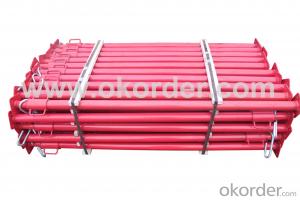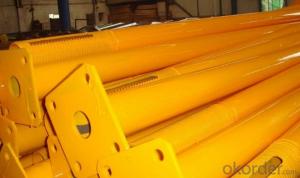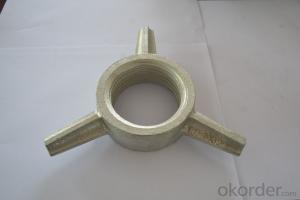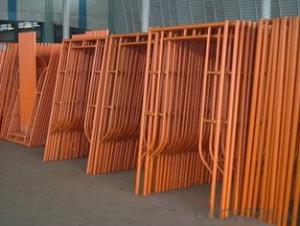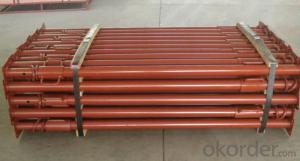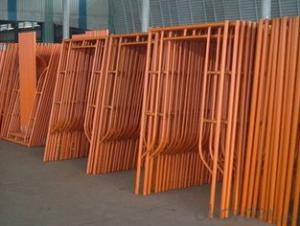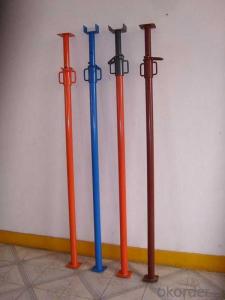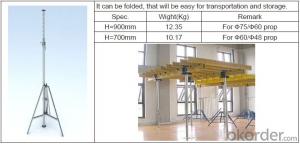Heavy Duty Adjustable Scaffolding Steel Prop
- Loading Port:
- China Main Port
- Payment Terms:
- TT OR LC
- Min Order Qty:
- -
- Supply Capability:
- -
OKorder Service Pledge
OKorder Financial Service
You Might Also Like
Quick Details
| Model Number: | |||||
| Type: | Scaffolding Part Type: | Color: | |||
| Surface treatment: | Using life: | Size: | |||
| Manufactuer: | Cerfiticate: | Feature: |
Packaging & Delivery
| Packaging Detail: | by stell pallet or customized |
| Delivery Detail: | 30 DAYS UPON PREYAYMENT |
Specifications
Scaffolding prop
1)Material:Q235 Q345
2)Durable steel prop
3)Length :0.8m--5m
Specification
Raw material | Q235/Q275/Q345 material | ||||
Height | 0.5-0.8m,0.7-1.2m,1.0-1.8m,1.2-1.7m,1.5-2.5m,1.6-2.9m,1.7-3.0m,1.8-3.2m,1.9-3.5m,2.0-3.5m,2.0-3.6m,2.1-3.9m,2.2-4.0m,2.3-4.2m,2.5-4.5m,3.0-5.0m,3.5-5.5m,4.0-6.0m | ||||
Thickness: | 1.6/1.8/1.9/2.0/2.2/2.5/2.75/3.0/3.25/3.5mm | ||||
Diameter | 48/40mm,56/48mm.60/48mm,76/60mm | ||||
Top/base plate | Square plate .Flower shape plate. 120*120mm,110*110mm,140*140mm,150*150mm | ||||
Size of prop sleeve | 60*3.25*200/220mm, 70*3.5*135mm,60*3.5*135mm | ||||
Diameter of lock pin | 10mm,12mm,14mm,16mm | ||||
Packing | Steel pallet | ||||
Delivery time | 30days upon the prepayment | ||||
Certificate | ISO9001:2000 | ||||
Application | Prop is applied to vertically support system in the construction to support the formwork.such as the floor construction | ||||
Structure | Steel prop is mainly made up of bottom plate.outer pipe.inner pipe.swivel nut.lock pin.top plate.and the accessories of folding tripod.head jack | ||||
Convenient | Steel prop is simple of the structure .it is easy to assemble and disassemble | ||||
Adjustment | Steel prop is adjustable by outer and inner pipe .the inner pipe could extend and shrink in the our pipe and then could adjusted according to the required height | ||||
Economy | Steel prop could be re-used ,and once useless.the material could be recovered | ||||
Practical using | Prop could be adjusted to required height according to the different height of the constructions | ||||
Length:M | External pipe:mm | Internal pipe:mm | Weight:kg | 20GP :pcs | Description |
0.8-1.4 | 48x1.6x765 | 40x1.8x835 | 4.74 | 3500 | Spanish prop |
1.6-3.0 | 48x1.6x1600 | 40x1.8x1600 | 7.6 | 2200 | |
2.0-3.5 | 48x1.6x1700 | 40x1.8x2000 | 8.5 | 2000 | |
2.2-4.0 | 48x1.6x2000 | 40x1.8x2200 | 9.4 | 1750 | |
1.6-2.9 | 56x1.6x1510 | 48x1.8x1600 | 8.95 | 2200 | Italian prop |
1.8-3.2 | 56x1.6x1510 | 48x1.8x1800 | 9.4 | 2100 | |
2.0-3.6 | 56x1.6x1750 | 48x1.8x2000 | 10.2 | 2000 | |
2.2-4.0 | 56x1.6x2010 | 48x1.8x2200 | 11.26 | 1750 | |
1.4-2.7 | 60x2.0x1340 | 48x2.0x1400 | 9.45 | 2300 | German prop |
2.0-3.5 | 60x2.0x1540 | 48x2.0x2000 | 11.38 | 2000 | |
2.2-4.0 | 60x2.0x1840 | 48x2.0x2200 | 12.7 | 1750 | |
3.0-5.5 | 60x2.0x2540 | 48x2.0x3000 | 16.5 | 1500 | |
2.1-3.9 | 60x3.0x1500 | 48x3.3x2100 | 17 | 1500 | Middle east |
3.0-5.5- | 60x3.0x2800 | 48x3.5x3000 | 23.2 | 1000 | |
- Q:Can steel props be used in school construction?
- Yes, steel props can be used in school construction. Steel props, also known as adjustable steel props or acrow props, are commonly used in the construction industry to support temporary structures and provide additional stability during construction. These props are adjustable in height and can be easily installed and removed, making them suitable for various construction projects, including school construction. They are particularly useful in situations where there is a need for temporary support, such as when installing beams, columns, or other structural elements. Steel props are strong, durable, and capable of withstanding heavy loads, making them a reliable choice for school construction projects.
- Q:Are steel props suitable for use in nuclear power plant construction?
- Nuclear power plant construction does not generally find steel props suitable. In order to meet the demands of nuclear power plants, materials with high strength, exceptional corrosion resistance, and the ability to withstand extreme conditions are required. While steel props may possess sufficient strength, they are vulnerable to corrosion in the presence of radiation and other harsh chemicals commonly found in nuclear environments. Reinforced concrete structures are commonly employed in nuclear power plants due to their superior performance. Concrete offers excellent radiation shielding and can endure high temperatures and pressures. Furthermore, concrete is non-combustible, a critical aspect in preventing potential fire hazards. Additionally, steel props can present challenges concerning maintenance and inspection within a nuclear power plant setting. The presence of radiation can cause steel to deteriorate over time, leading to issues with structural integrity. This could greatly jeopardize the safety and dependability of the power plant. In conclusion, the use of steel props in nuclear power plant construction is not advised due to their vulnerability to corrosion, potential problems with structural integrity, and the superior suitability of reinforced concrete structures in this particular industry.
- Q:Can steel props be used in the construction of offshore platforms or oil rigs?
- Indeed, offshore platforms or oil rigs can make use of steel props during their construction. Commonly employed in construction projects, steel props offer support to temporary structures like formwork or scaffolding. Their primary purpose is to provide vertical support and stability during construction activities. In the case of offshore platforms or oil rigs, steel props find application in supporting various components such as decks, modules, or equipment during the construction phase. By distributing the weight of these structures, steel props ensure their stability even in the harsh offshore environment. Steel props are favored in offshore construction due to their capacity to bear heavy loads, durability, and resistance to corrosion. They are typically crafted from high-strength steel and engineered to withstand the demanding conditions encountered offshore, including strong winds, rough seas, and corrosive saltwater. Moreover, steel props can be easily adjusted and adapted to accommodate changes in the construction process or provide additional support where necessary. Their modular design enables swift installation and removal, making them a practical choice for offshore construction projects that demand flexibility and efficiency. However, it is essential to note that the utilization of steel props in offshore platforms or oil rigs is typically confined to the construction phase. Once permanent structures are in place, steel props are no longer necessary and are usually dismantled. The permanent structures themselves are designed to provide the required support and stability during the operational phase of the offshore platform or oil rig.
- Q:Can steel props be used in temporary support for roof structures?
- Yes, steel props can be used in temporary support for roof structures. Steel props are commonly used in construction to provide temporary support and stability to various structures, including roofs. They are adjustable and can withstand heavy loads, making them suitable for temporary use during roofing projects or repairs.
- Q:Do you have a 400*16 model of steel support
- It is not a question of how the steel supports have the type of the 400*16, but what you need to do to support the design of the load, force, material, etc.. After the calculation, what need to support what support. 400*16 is also one of the options.
- Q:What are the potential noise or vibration concerns when using steel props?
- There are several possible noise or vibration concerns that may arise when steel props are used. Firstly, the inherent characteristics of steel props can result in noise and vibrations. Due to its density, steel can effectively transmit vibrations and sounds, unlike materials such as wood or plastic. This means that audible noise and vibrations can be transferred to the surrounding environment, potentially causing disturbances to nearby occupants or neighboring structures. Furthermore, if the steel props are not installed or adjusted properly, they may not be stable and can produce rattling or vibrating sounds. This can happen if the props are not tightly secured or aligned correctly, leading to movement and resulting in noise and vibrations. Moreover, the type of work being done with steel props can also contribute to noise and vibration concerns. For instance, if heavy machinery is used alongside the props, such as in construction or demolition activities, the operation of these machines can generate significant noise and vibrations. The steel props may amplify these vibrations, potentially creating a louder and more disruptive environment. To address these concerns, it is crucial to ensure that the steel props are installed and adjusted correctly, following manufacturer guidelines and best practices. Regular inspections and maintenance should also be carried out to identify and fix any loose or misaligned props that might be contributing to noise or vibration problems. Additionally, implementing measures to control noise and vibrations, such as using vibration isolation pads or installing sound barriers, can help minimize the impact of noise and vibrations generated by steel props.
- Q:What are the common load distribution methods for steel props?
- There are several common load distribution methods for steel props that are widely used in the construction industry. One of the most common methods is the use of timber or steel needles in conjunction with steel props. This involves placing horizontal beams (needles) across the top of multiple props, which helps distribute the load evenly across the props. The needles are typically supported by steel or timber supports at regular intervals to ensure stability and prevent any bending or sagging. Another common method is the use of steel spreader plates. Spreader plates are flat, steel plates that are placed on top of the prop's base plate. These plates help to evenly distribute the load across a larger surface area, reducing the risk of localized pressure points and ensuring stability. In some cases, adjustable steel frames or frames with multiple props may be used. These frames consist of multiple props connected by horizontal beams or braces, creating a rigid structure that can handle heavier loads. By distributing the load among multiple props, these frames help to evenly distribute the weight and increase stability. Additionally, the use of load-bearing beams or lintels can also help distribute the load from above. These beams are supported by steel props and are used to transfer the load to the props, effectively distributing the weight across multiple points. It is important to note that the appropriate load distribution method will depend on the specific requirements of the construction project, including the weight and size of the load, the span between the props, and the desired level of stability. Consulting with a structural engineer or an experienced professional is recommended to determine the most suitable load distribution method for steel props in a particular construction scenario.
- Q:I would like to ask how the cost of steel support how the composition of the material composition of the number of what the size of the various specifications of how much raw materials are required
- The cost of steelmaking process is mainly composed of pig iron, scrap steel, alloy, electrode, refractory material, auxiliary material, electricity, inspection and other expenses. At present, the main China steelmaking equipment for smelting converter and electric furnace, based on the different principle, converter and electric furnace in the main raw materials (iron and steel) ratio of certain differences, scrap converter process usually takes 10% of the usage and configuration, the electric furnace process scrap accounted for 80%.
- Q:How do steel props contribute to the overall stability of a structure?
- Steel props contribute to the overall stability of a structure by providing temporary support and bracing during construction or renovation. These adjustable steel supports are strategically placed to bear the load of the structure, preventing any potential collapse or deformation. By distributing the weight evenly and transferring it to the ground, steel props help maintain the structural integrity and ensure the safety of workers and the building itself.
- Q:What are the common maintenance practices for steel props?
- Common maintenance practices for steel props include regular cleaning and inspection to remove dirt, rust, and any other contaminants. It is important to lubricate the moving parts to prevent friction and ensure smooth operation. Regular checks should be conducted to identify any damage or wear and tear, and repairs or replacements should be made promptly. Additionally, storing the props in a dry and well-ventilated area helps to prevent corrosion and prolong their lifespan.
1. Manufacturer Overview |
|
|---|---|
| Location | |
| Year Established | |
| Annual Output Value | |
| Main Markets | |
| Company Certifications | |
2. Manufacturer Certificates |
|
|---|---|
| a) Certification Name | |
| Range | |
| Reference | |
| Validity Period | |
3. Manufacturer Capability |
|
|---|---|
| a)Trade Capacity | |
| Nearest Port | |
| Export Percentage | |
| No.of Employees in Trade Department | |
| Language Spoken: | |
| b)Factory Information | |
| Factory Size: | |
| No. of Production Lines | |
| Contract Manufacturing | |
| Product Price Range | |
Send your message to us
Heavy Duty Adjustable Scaffolding Steel Prop
- Loading Port:
- China Main Port
- Payment Terms:
- TT OR LC
- Min Order Qty:
- -
- Supply Capability:
- -
OKorder Service Pledge
OKorder Financial Service
Similar products
New products
Hot products
Hot Searches
Related keywords



